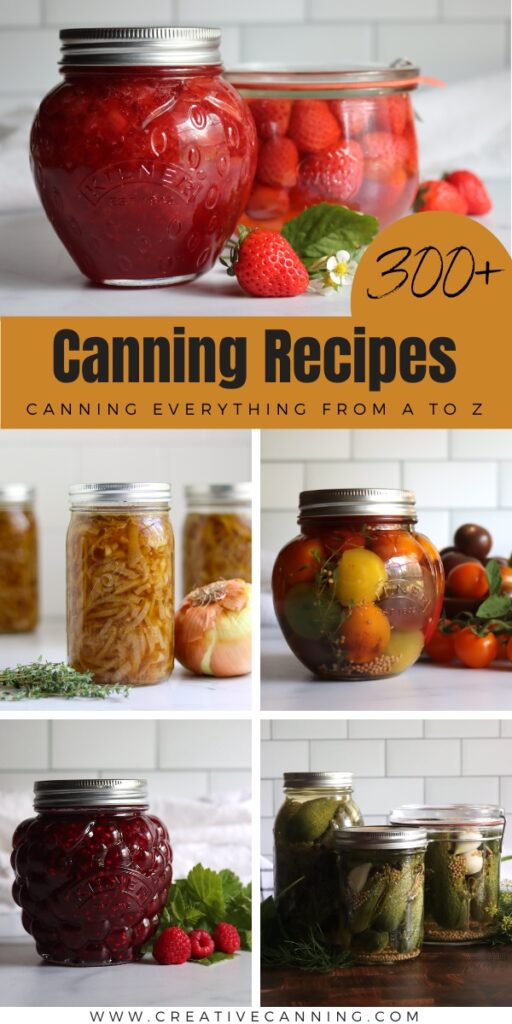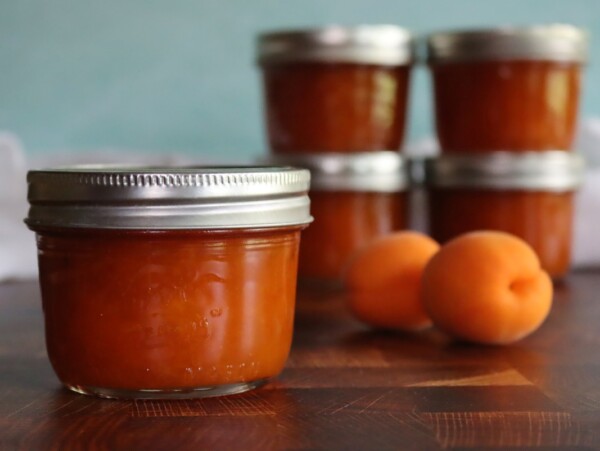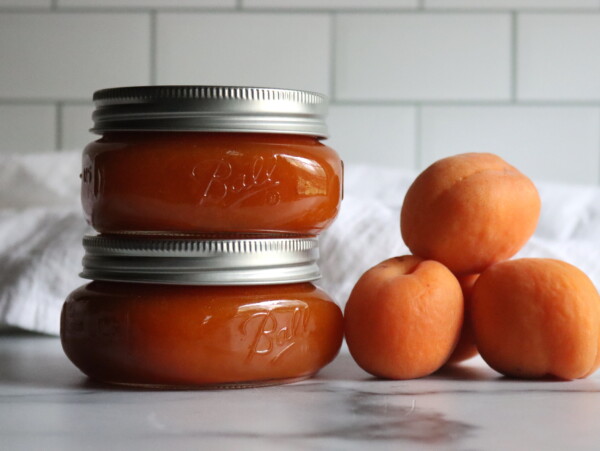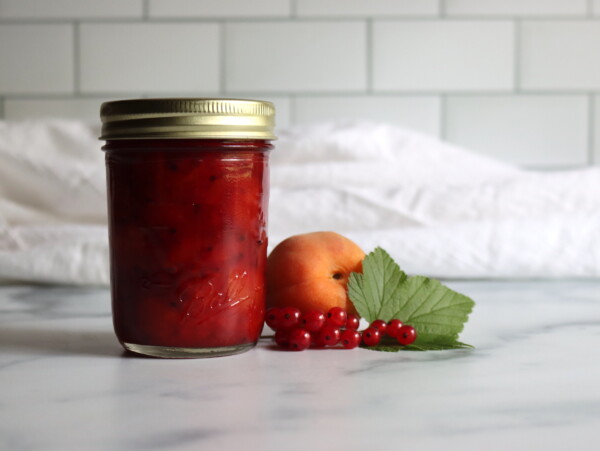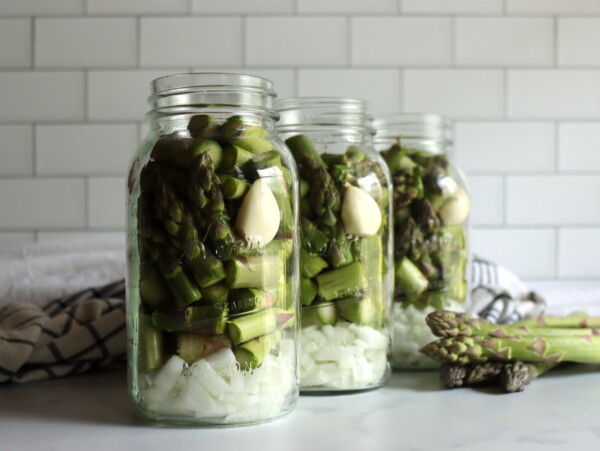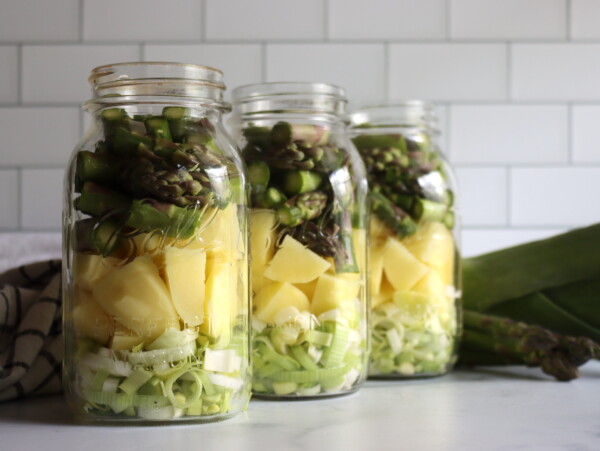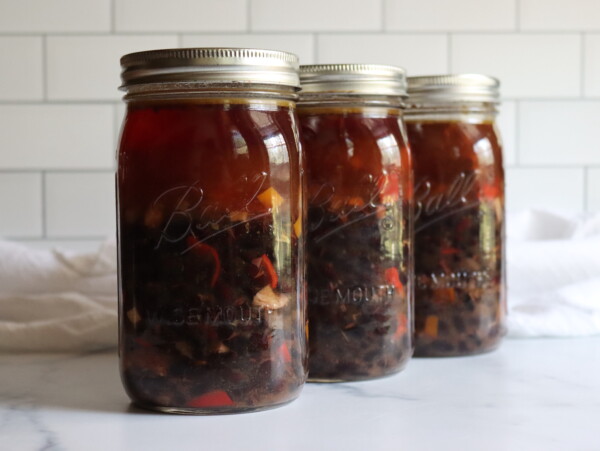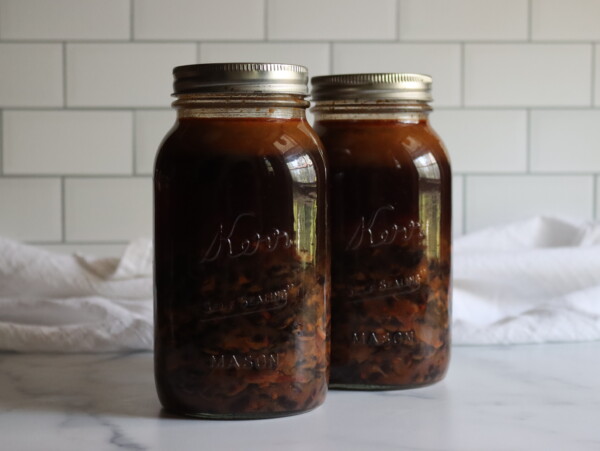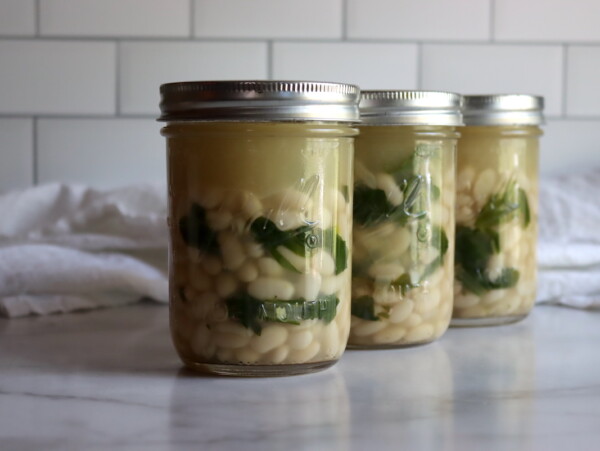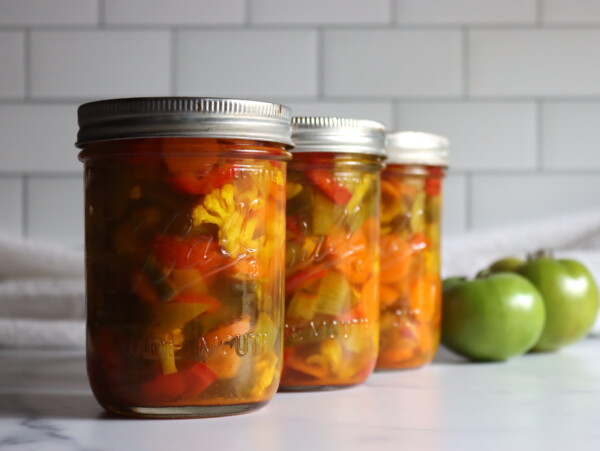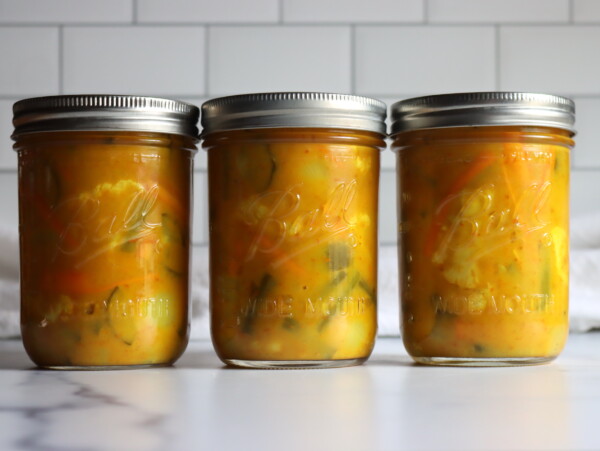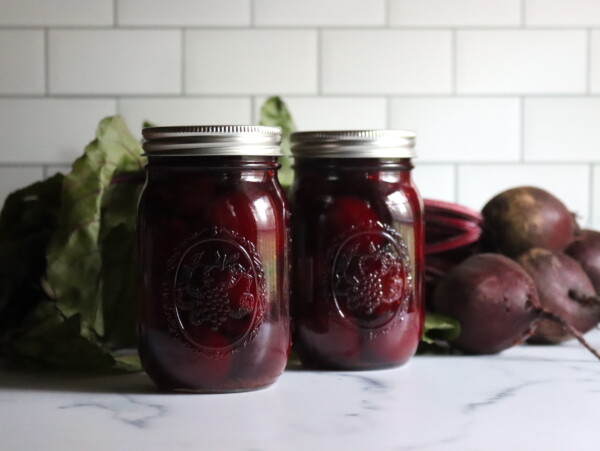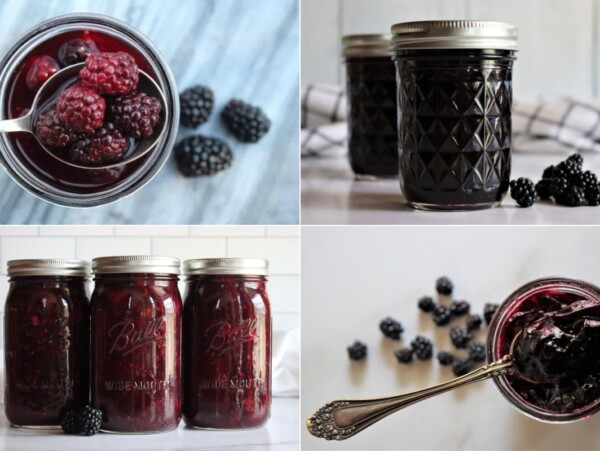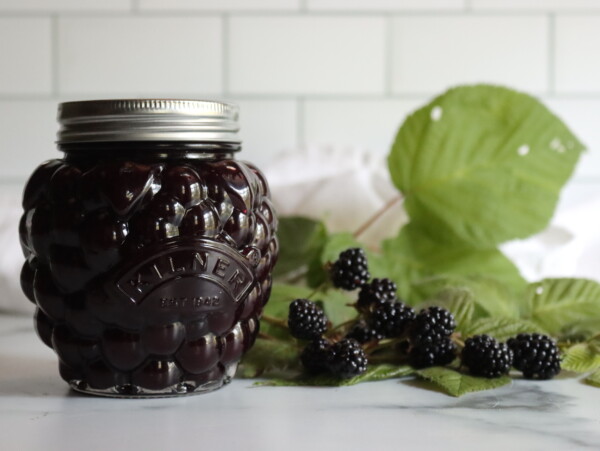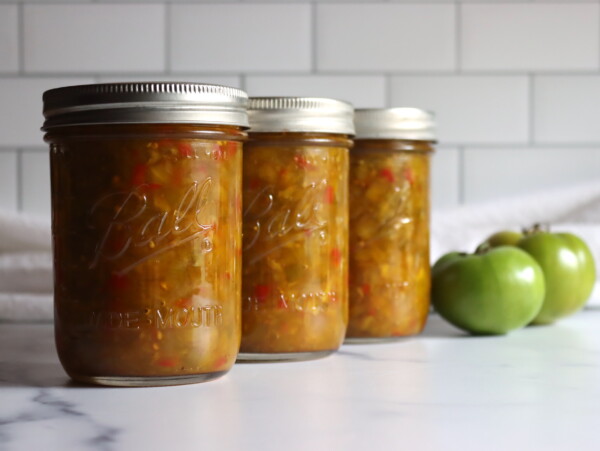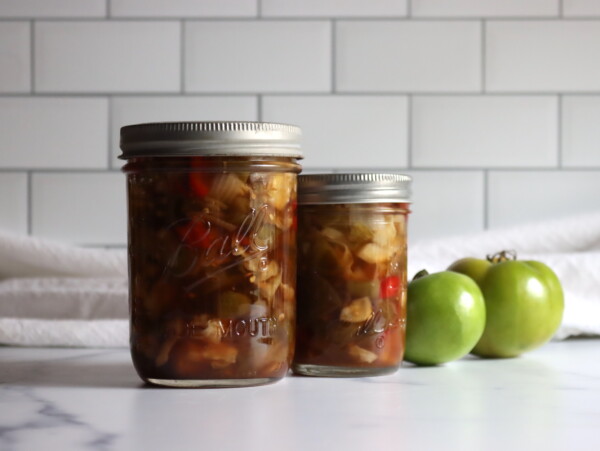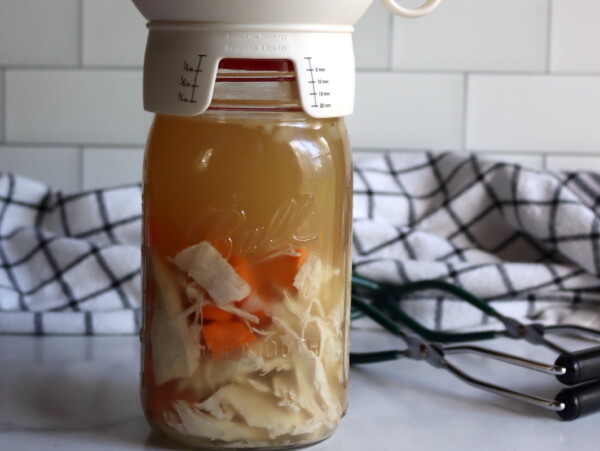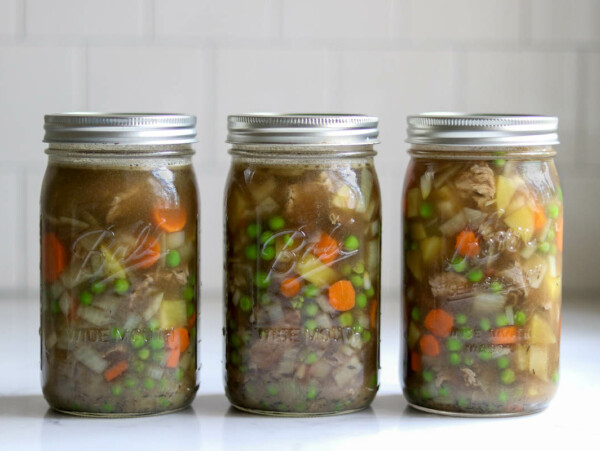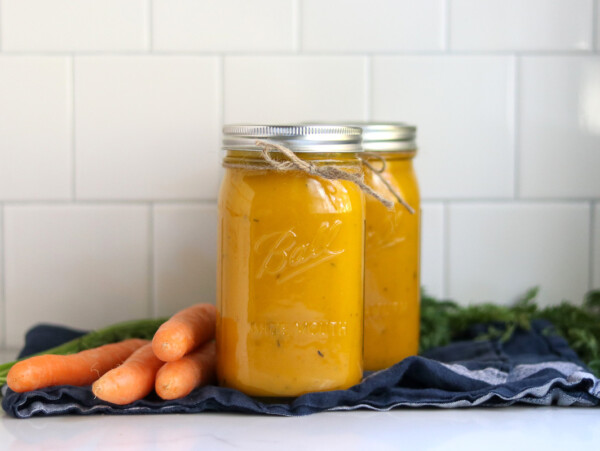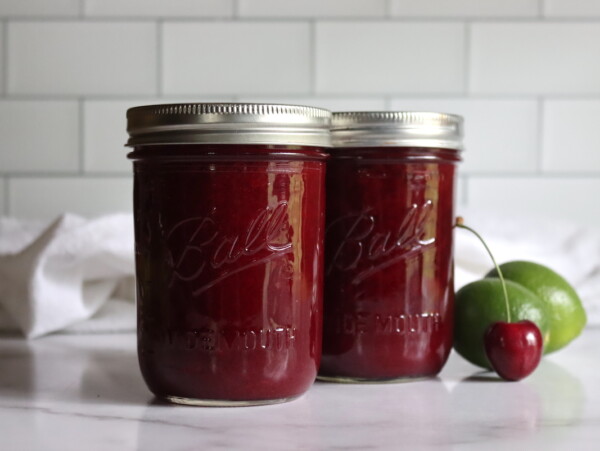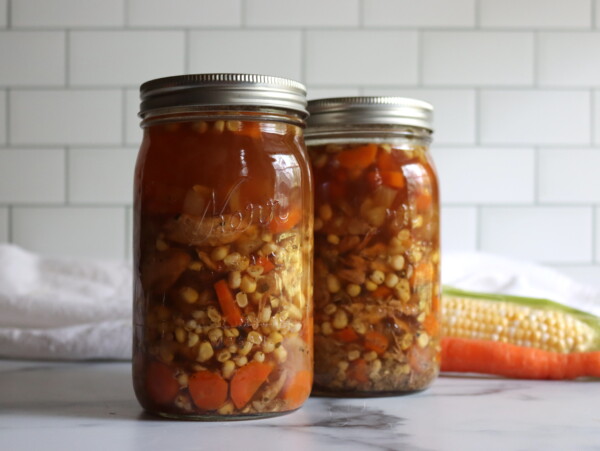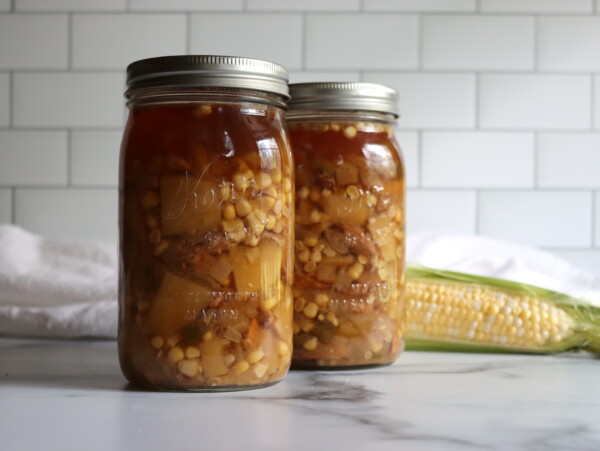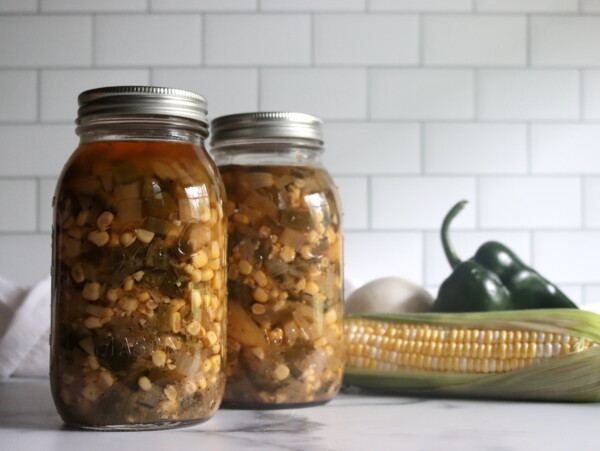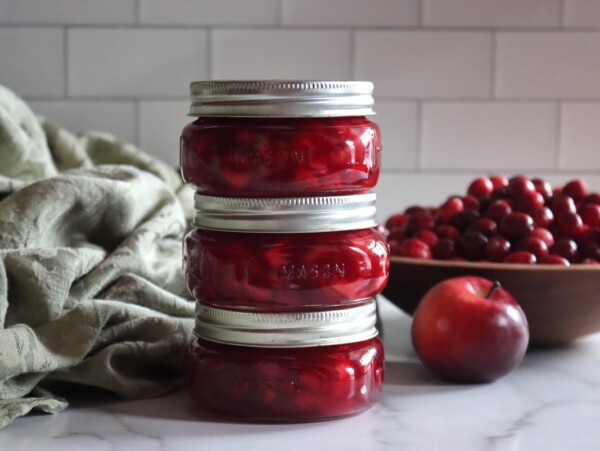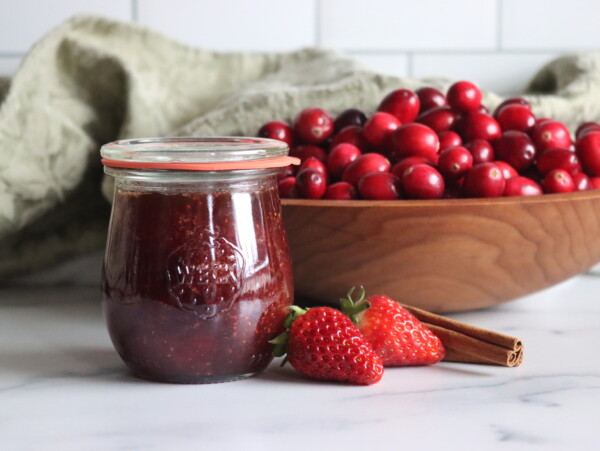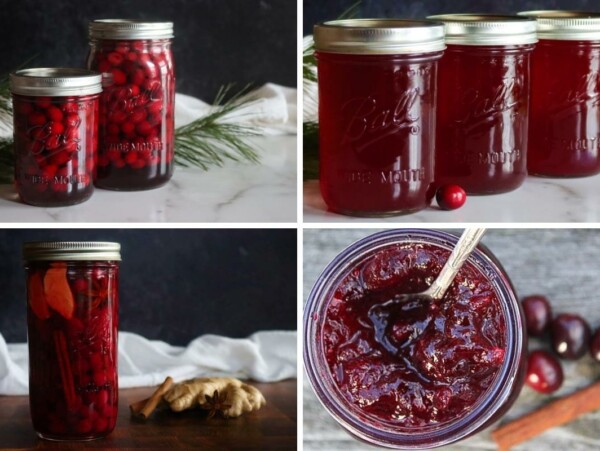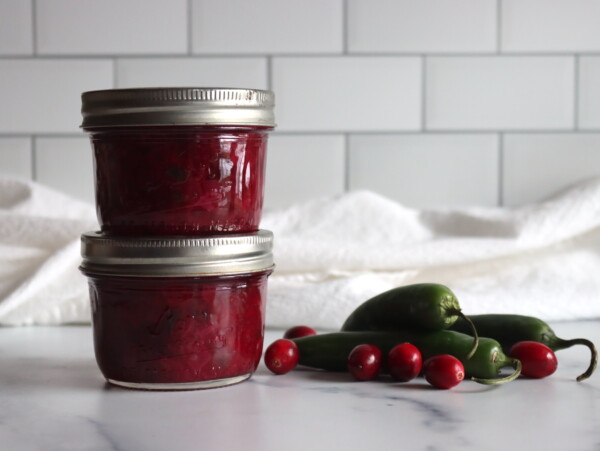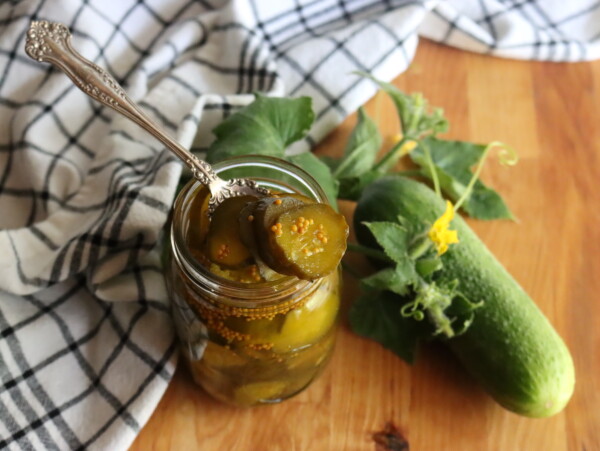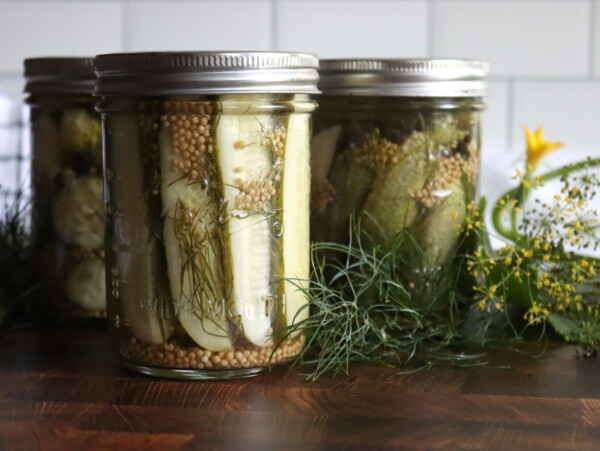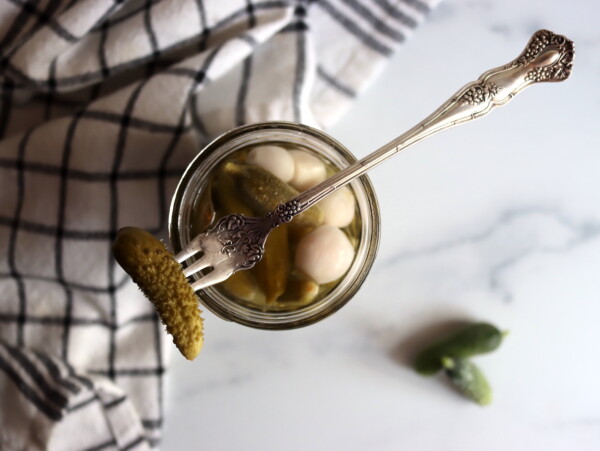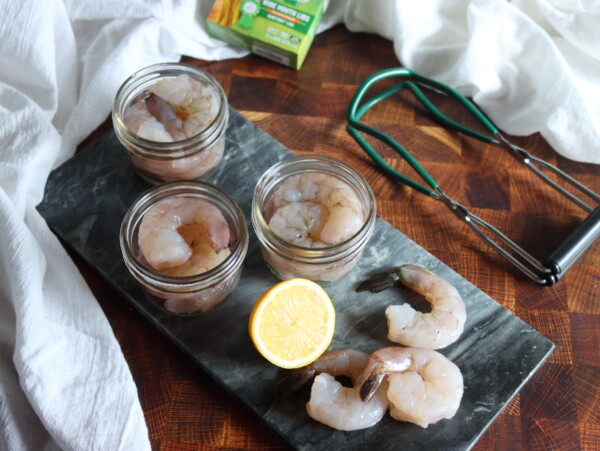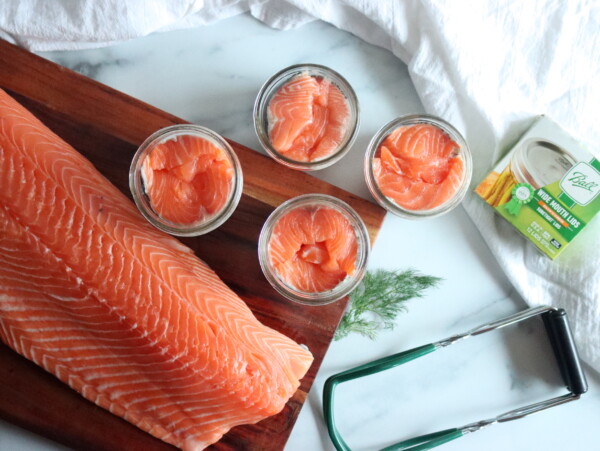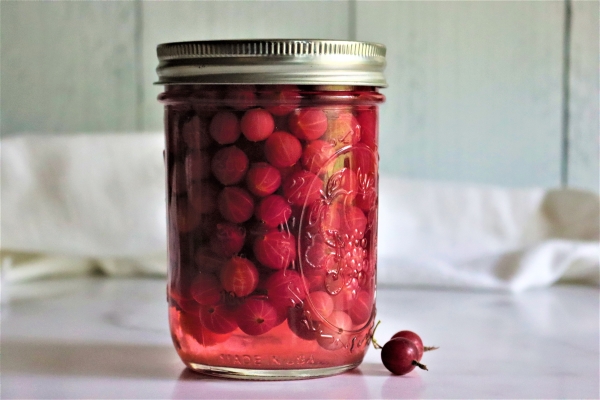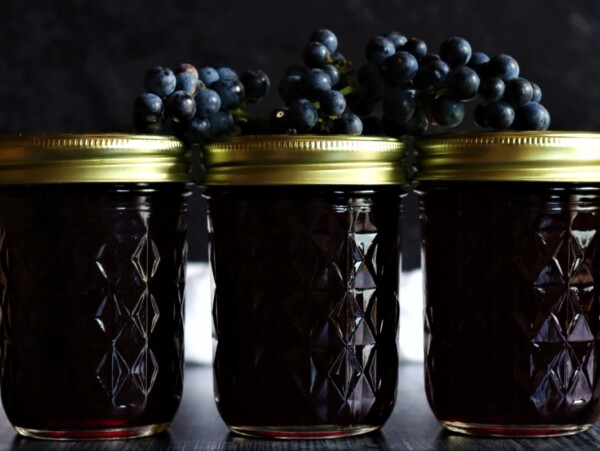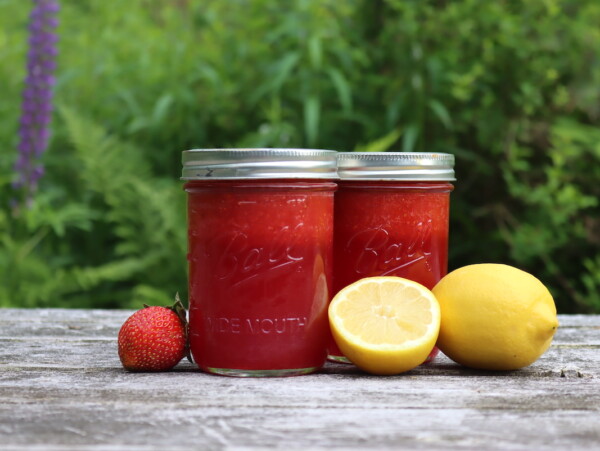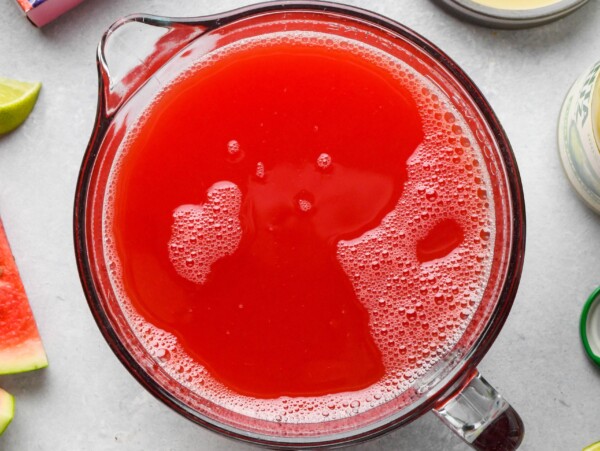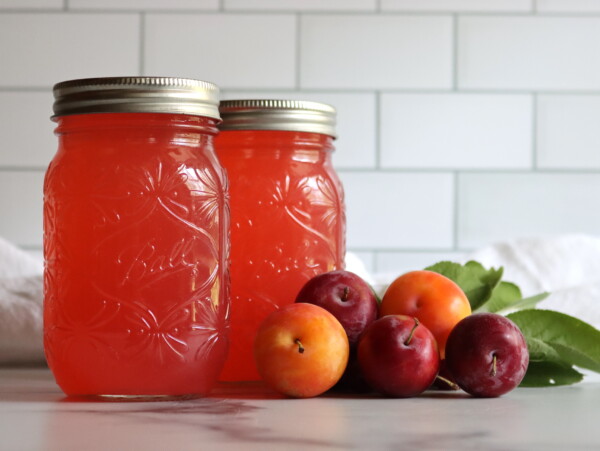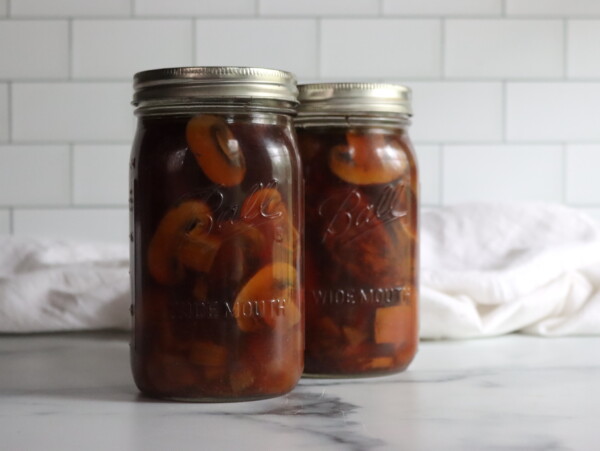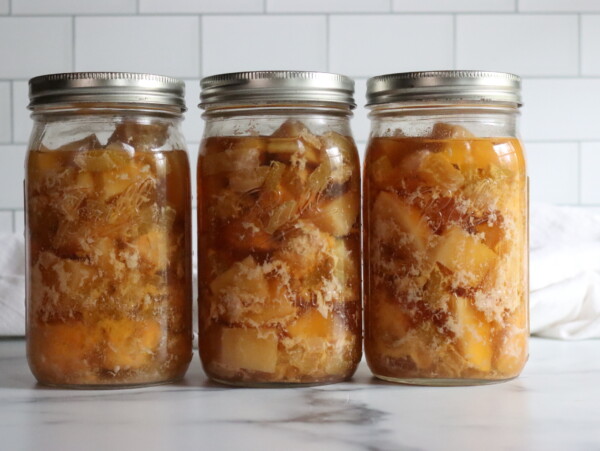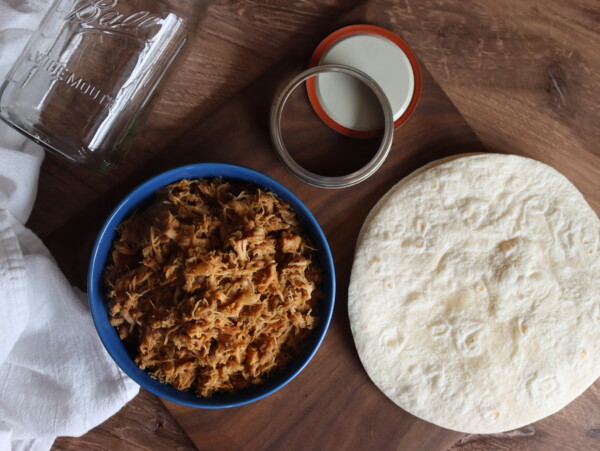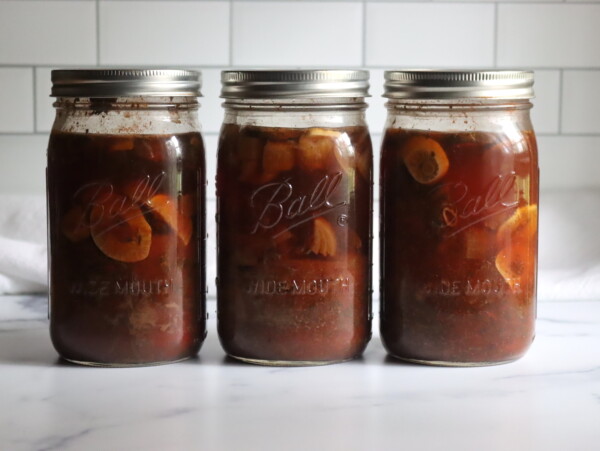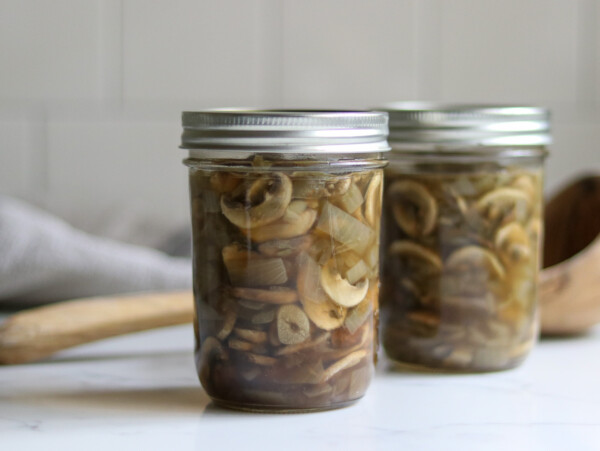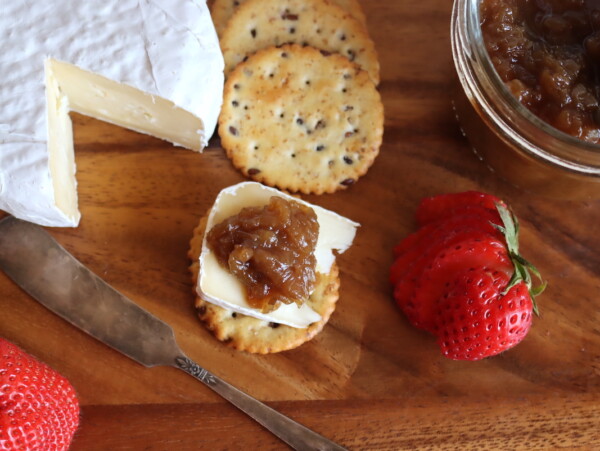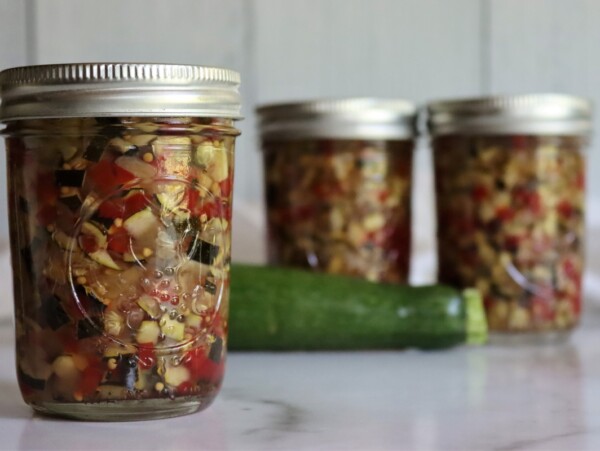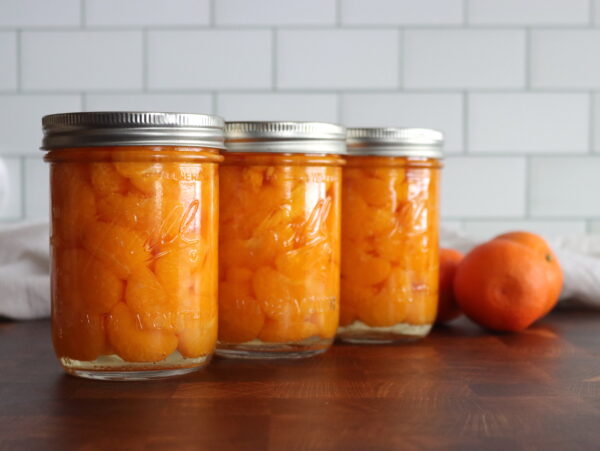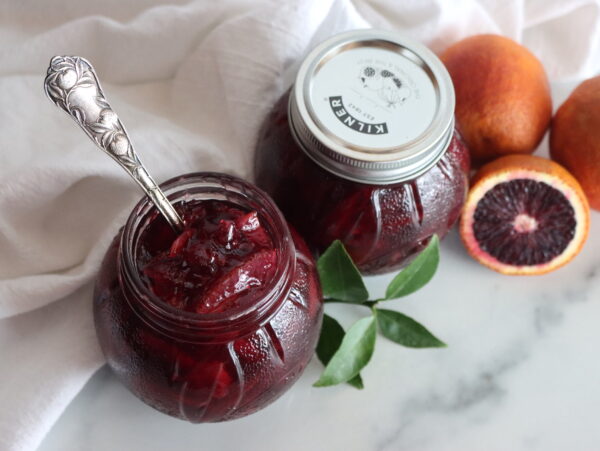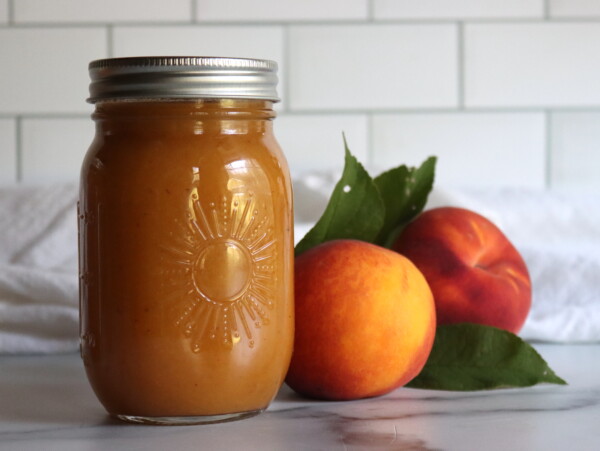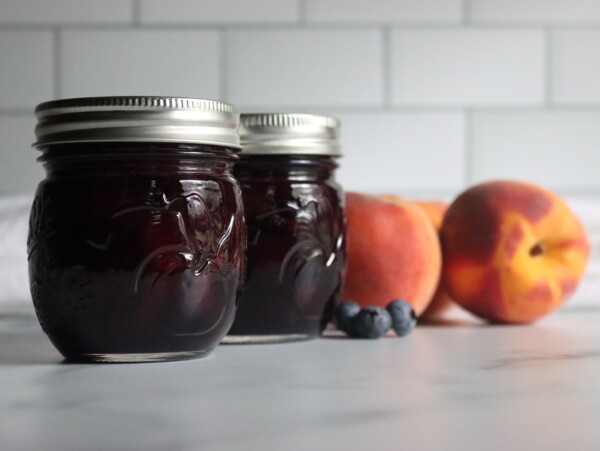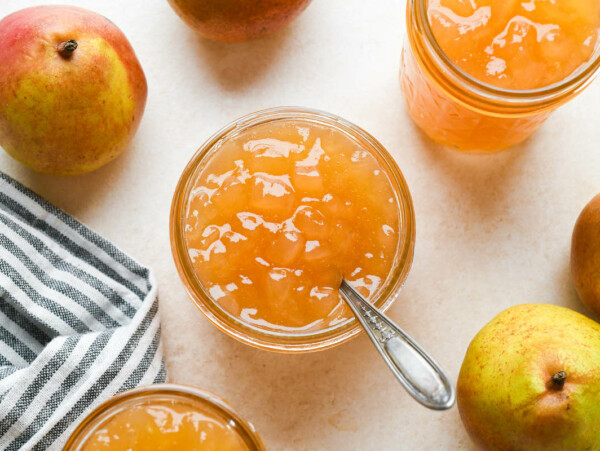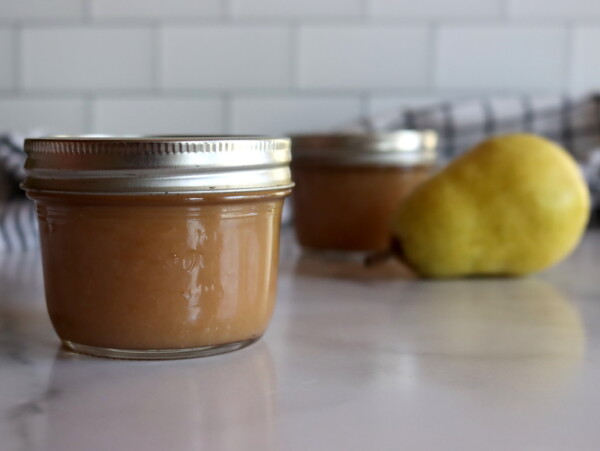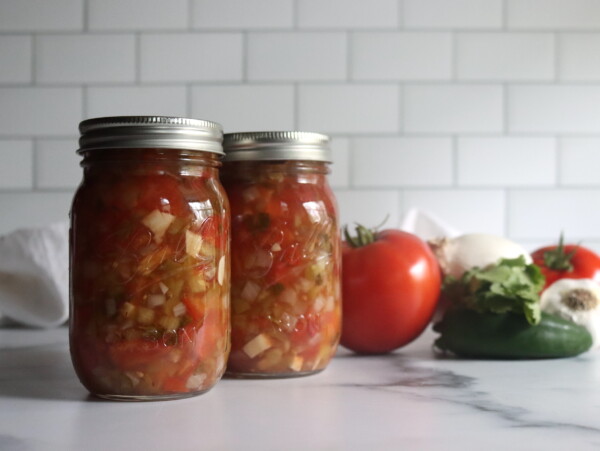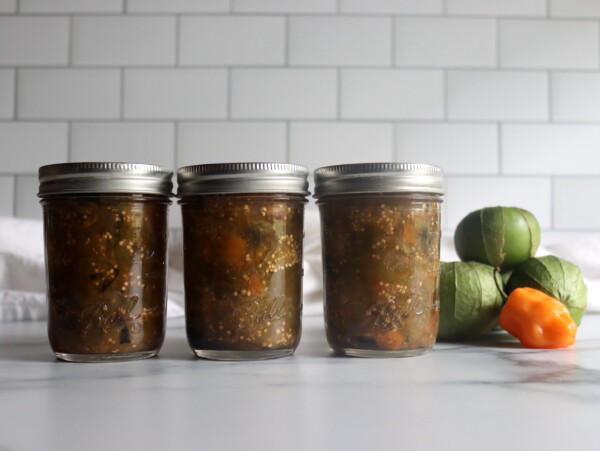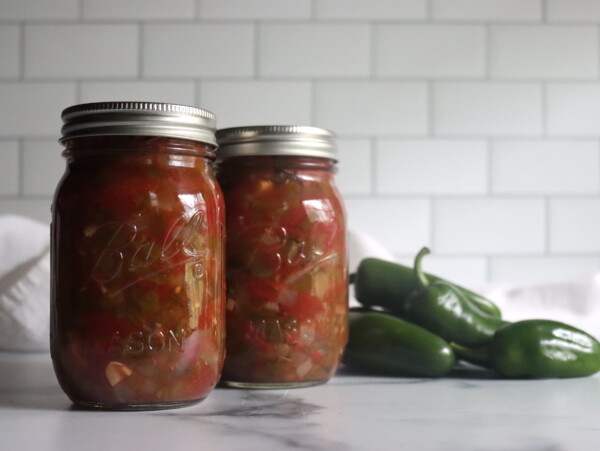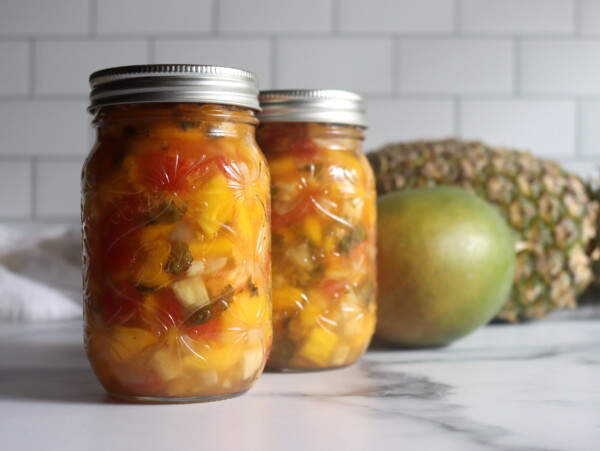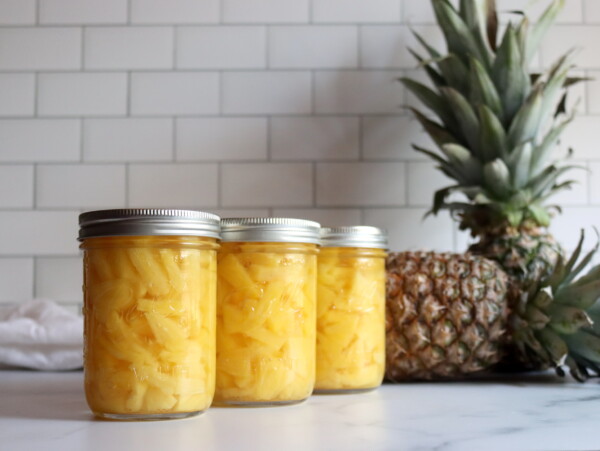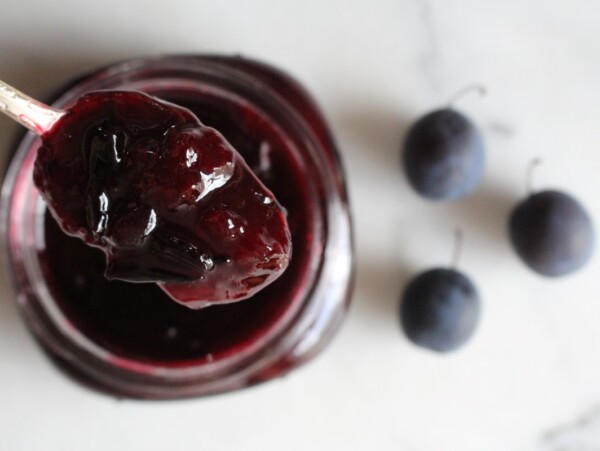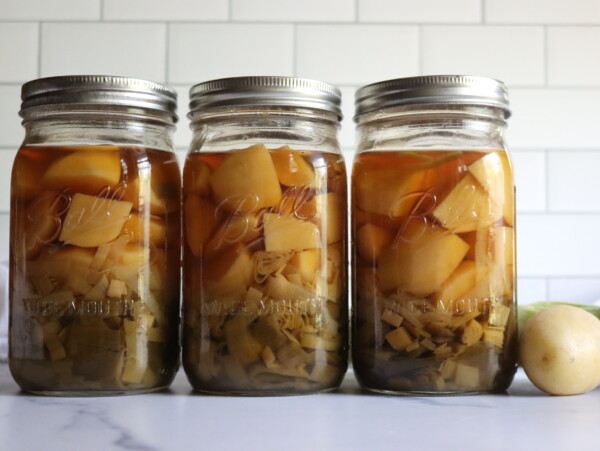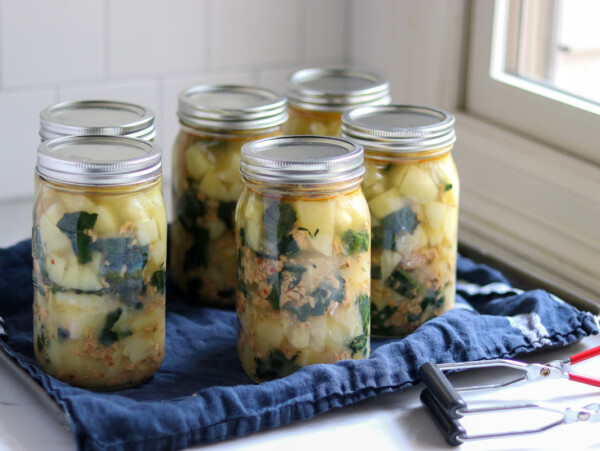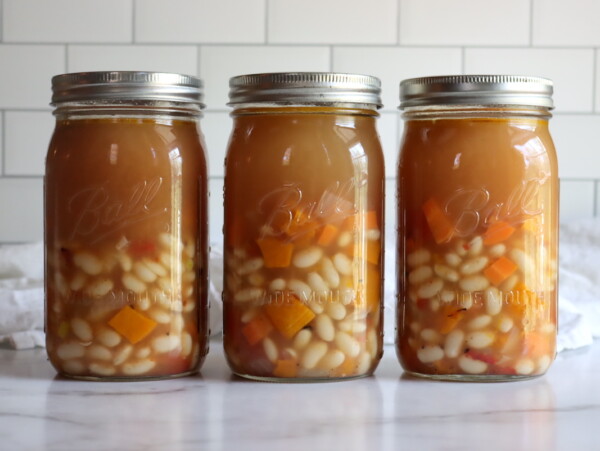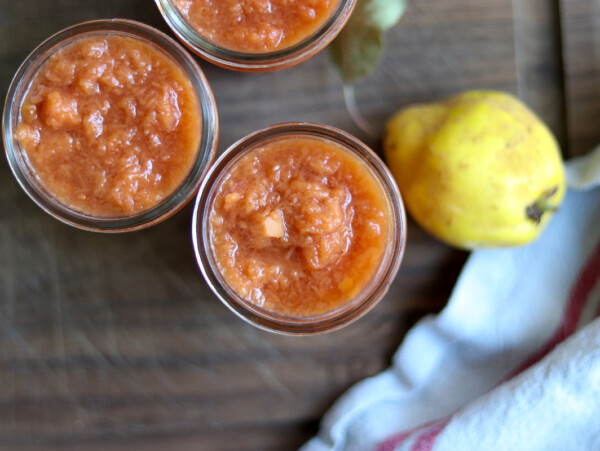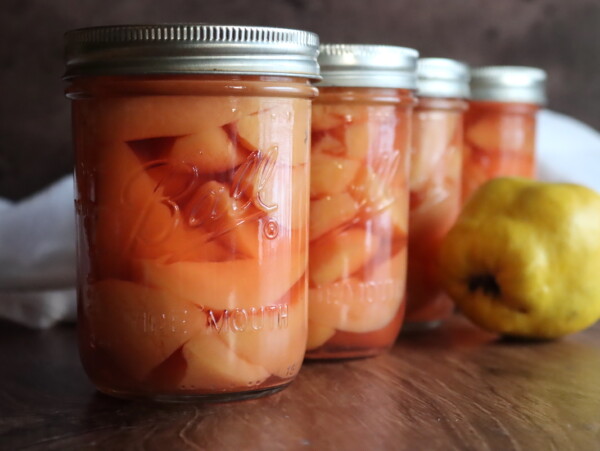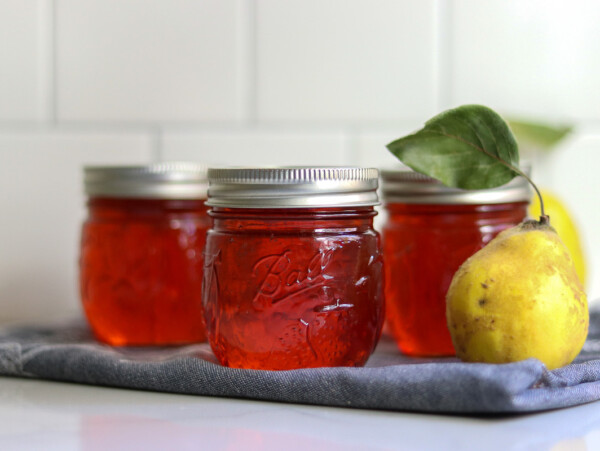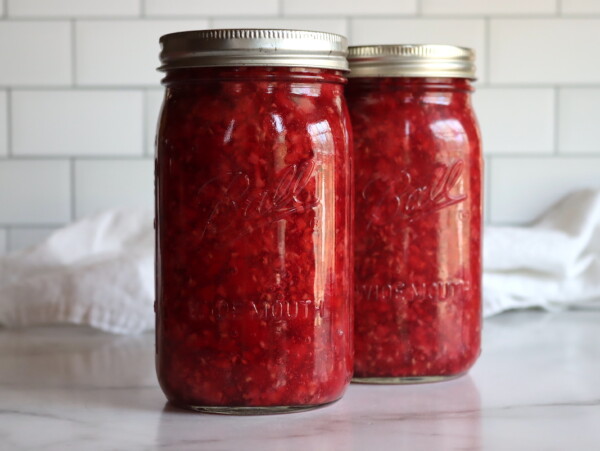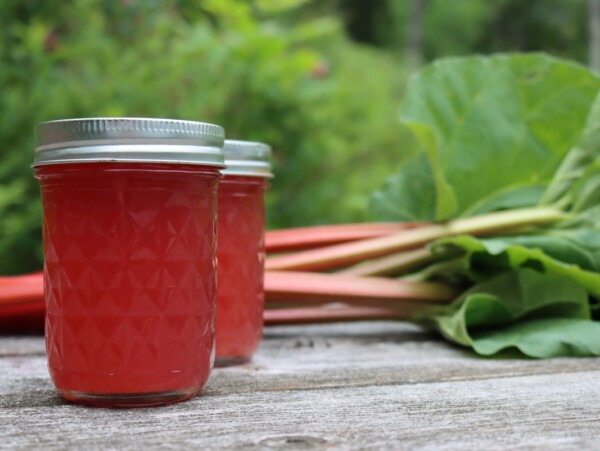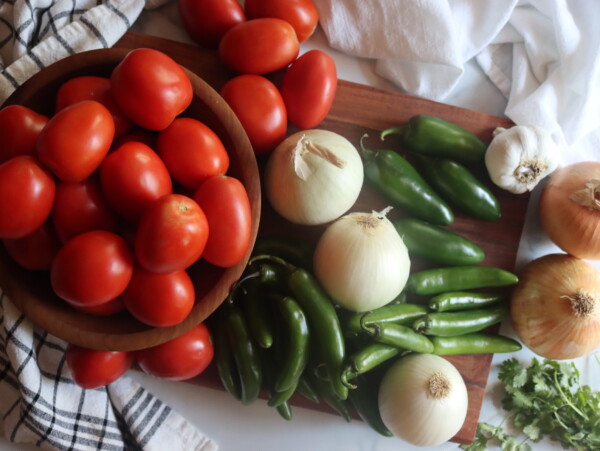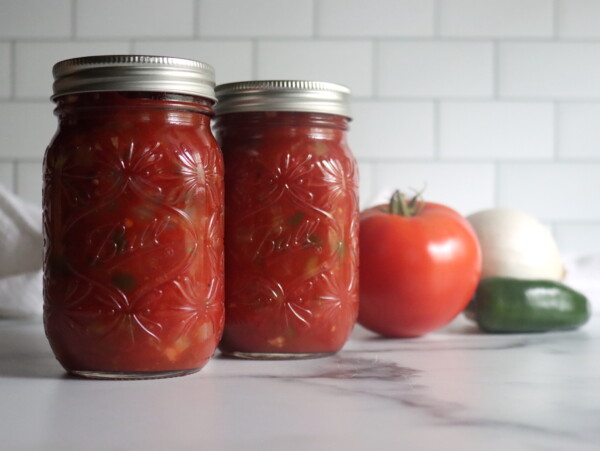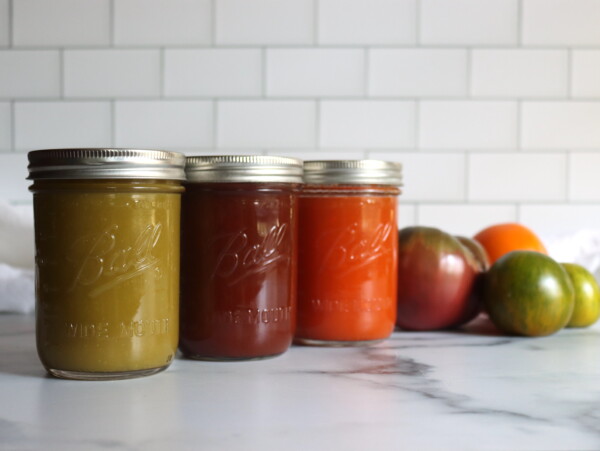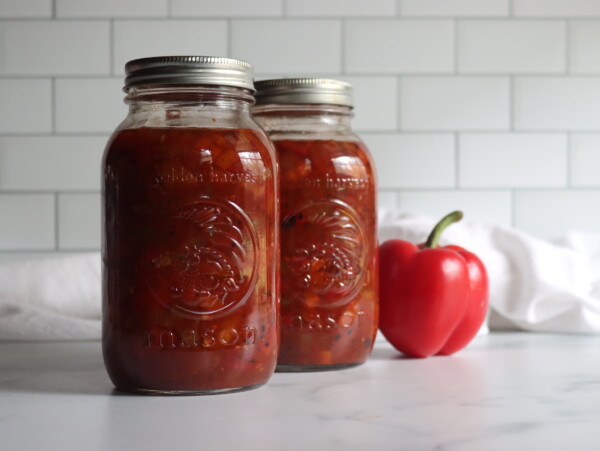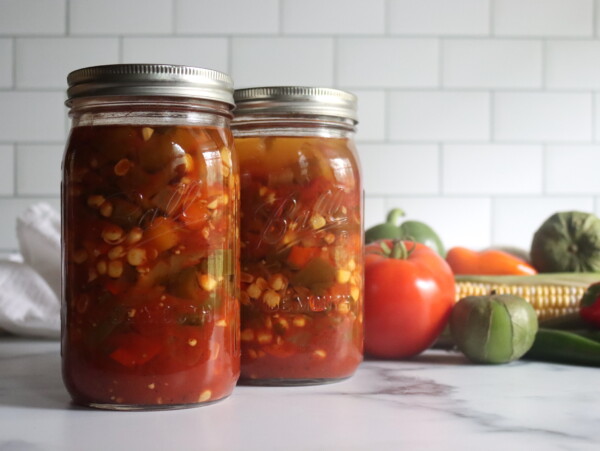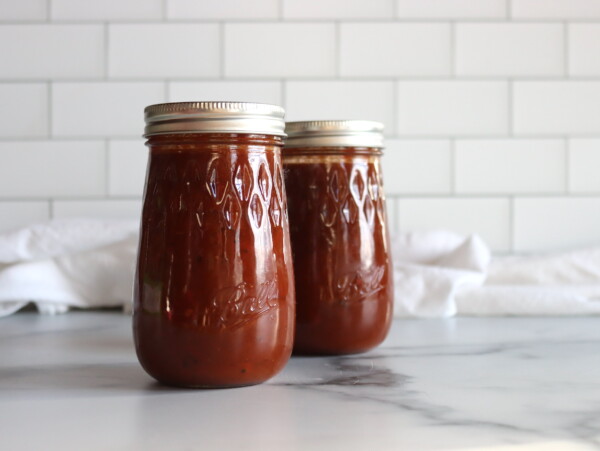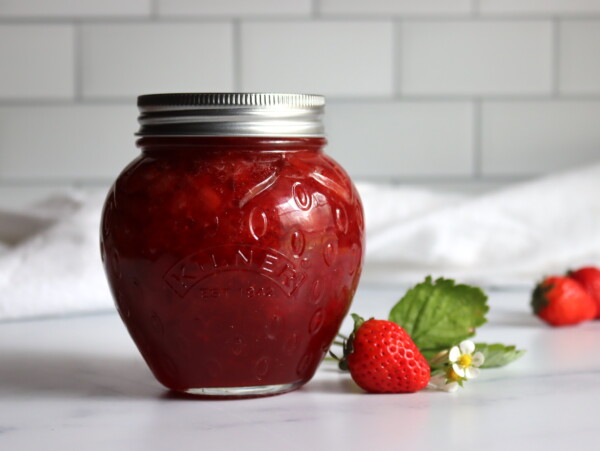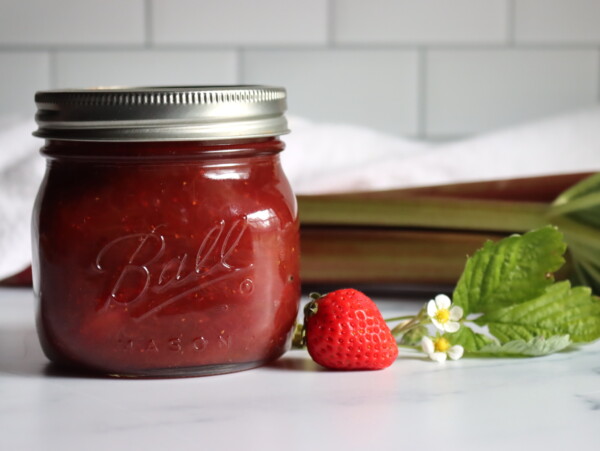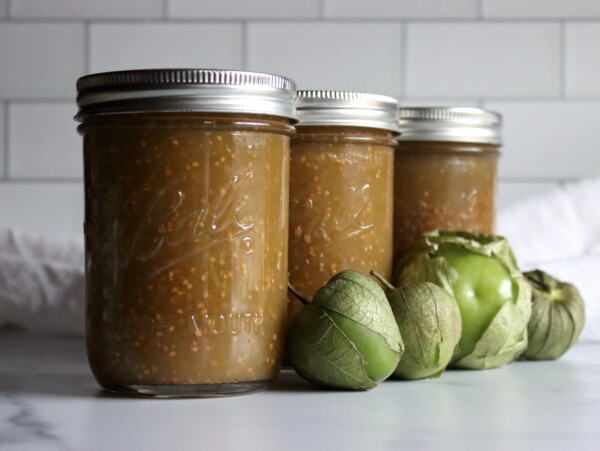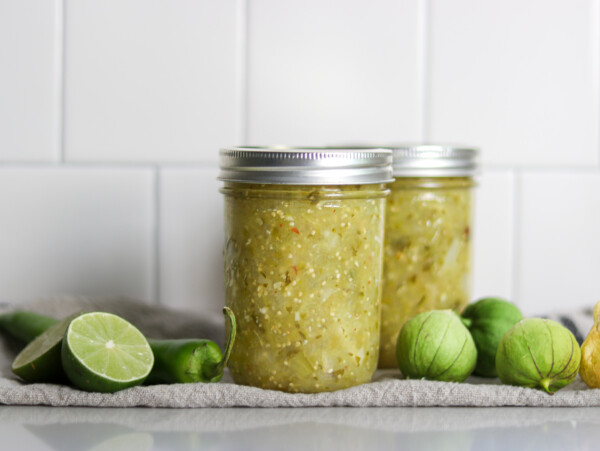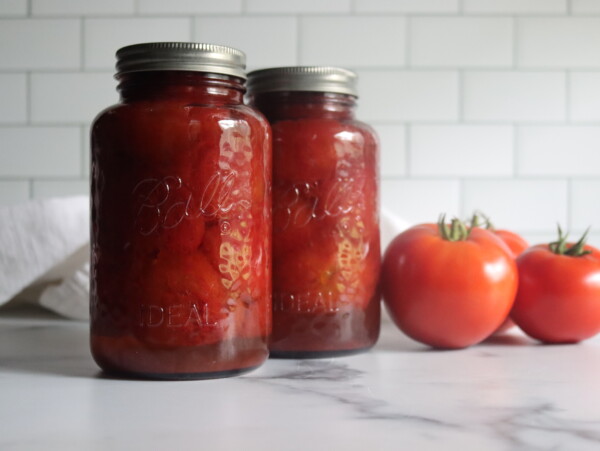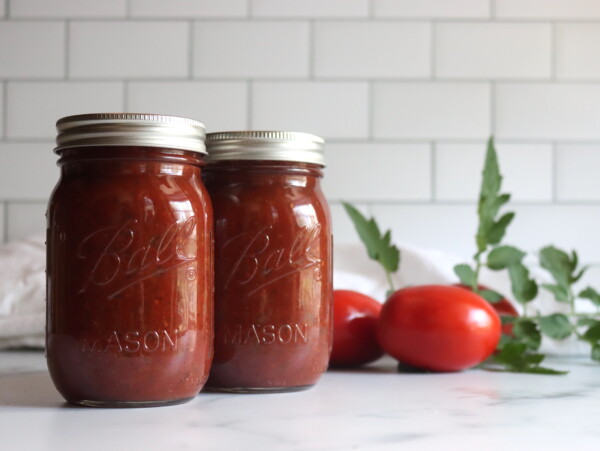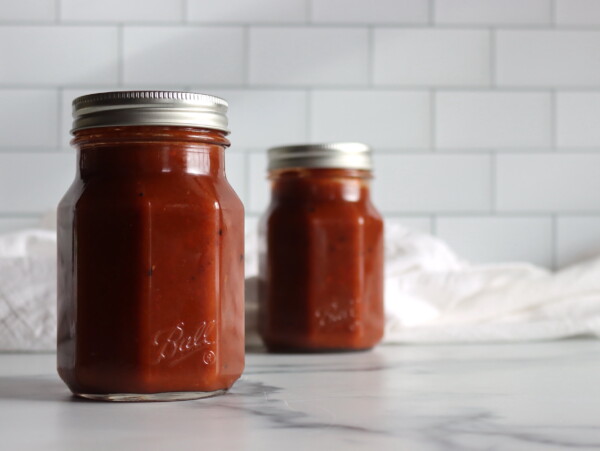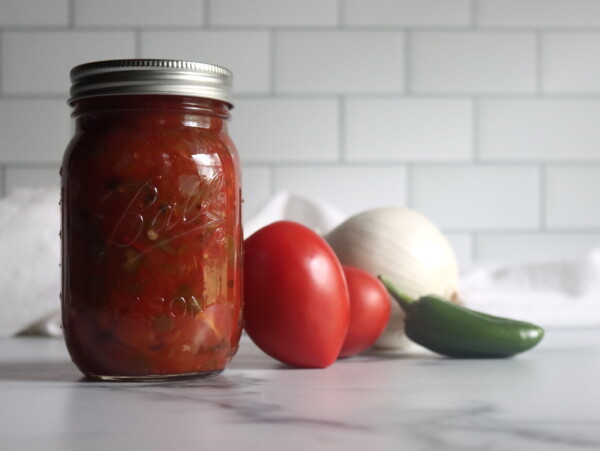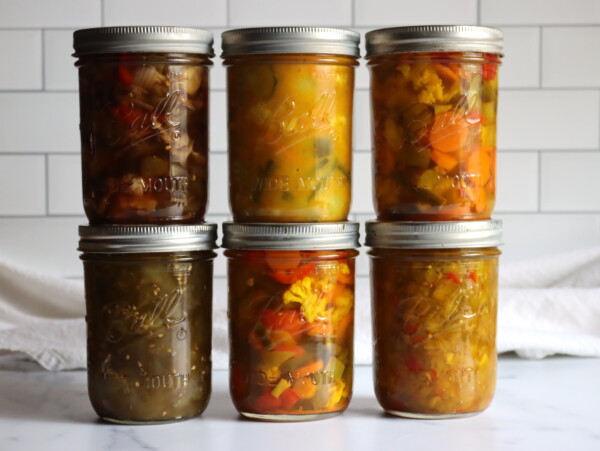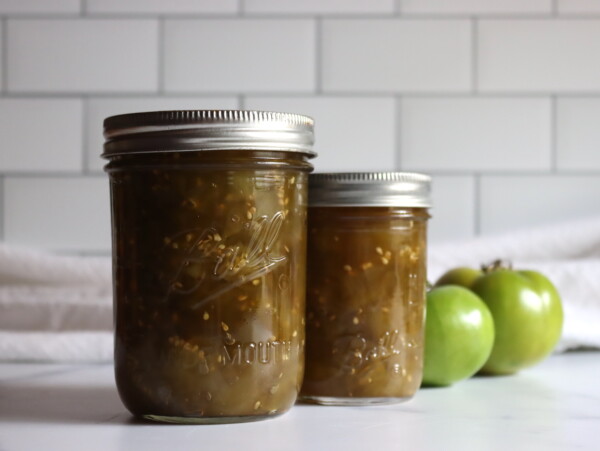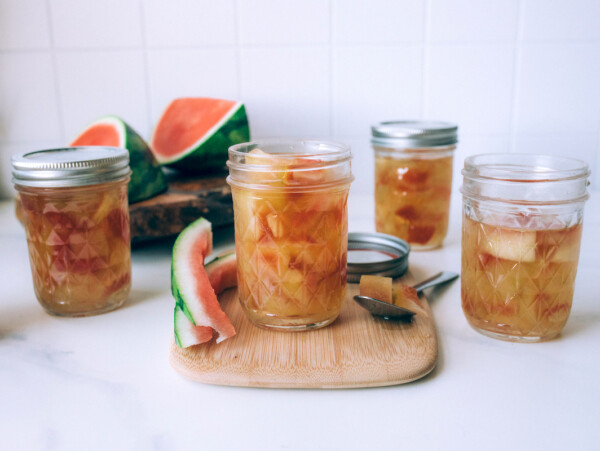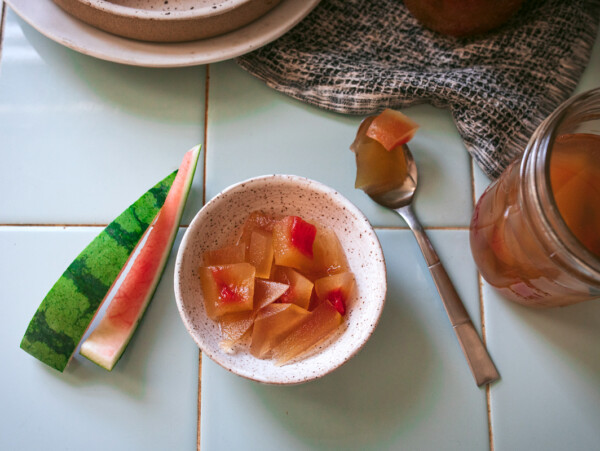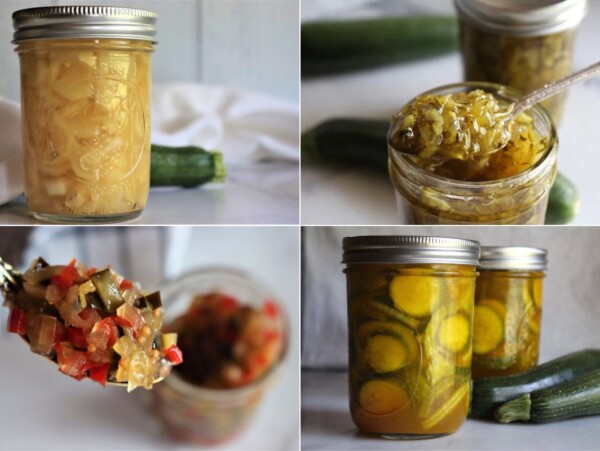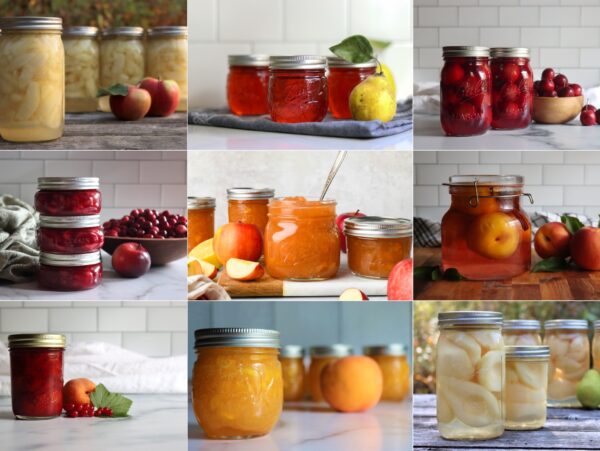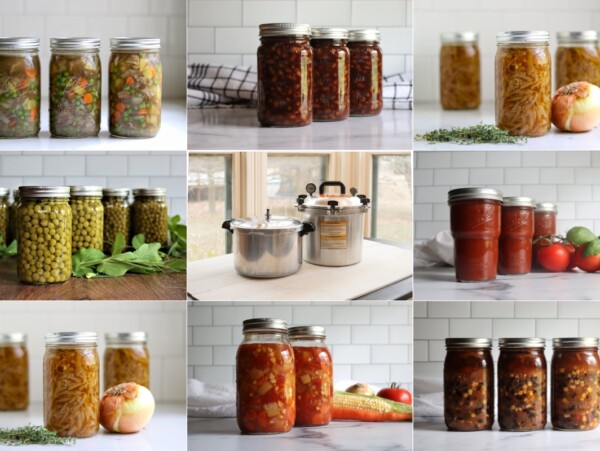This post may contain affiliate links. Please see our disclosure policy.
Canning recipes can be hard to find in season, especially when you have a bumper crop of produce on hand. Not to worry, I have hundreds of canning recipes sorted by ingredient, ready to use at the click of a button here on Creative Canning.
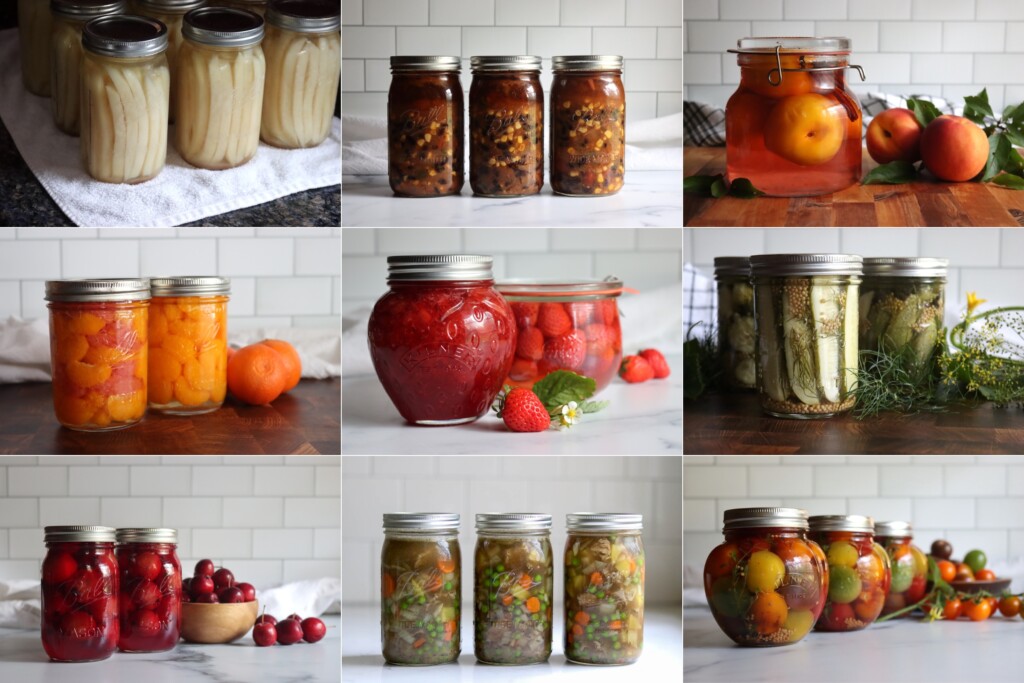
Table of Contents
- Apples
- Apricots
- Asparagus
- Beans (Dry Beans)
- Beans (Green)
- Beets
- Blackberries
- Broth & Stock
- Cabbage
- Currants
- Carrots
- Cauliflower
- Cherry
- Corn
- Cranberries
- Cucumbers
- Elderberries
- Figs
- Fish & Seafood
- Flowers (Edible Varieties)
- Gooseberries
- Grapes
- Lemons
- Meat
- Mushrooms
- Onion
- Orange
- Papaya
- Peaches
- Pears
- Peas
- Peppers
- Pineapple
- Plum
- Potato
- Pumpkin (& Winter Squash)
- Quince
- Raspberry (& Black Raspberry)
- Rhubarb
- Salsa
- Soup
- Strawberry
- Tomatillo
- Tomatoes
- Tomatoes (Unripe Green)
- Watermelon (& Other Melons)
Apricots
The house I grew up in in California had a large apricot tree. Each summer, the fruit would ripen all at once, and we would be buried in apricots. My parents still have the same issue, and while they freeze plenty of apricots, my mom was looking for other ways to preserve them, so I started gathering these apricot canning recipes. Apricot jam is common, but a person can only eat so much.
Thankfully, I found several creative recipes that are all delicious ways to can apricots, including everything from sweet recipes like apricot pie filling, apricot jelly and apricot butter, to savory recipes like apricot BBQ sauce.
Asparagus
I must admit that canned asparagus holds a special place in my heart. I grow and enjoy plenty of fresh asparagus on my homestead, but the canned version was a staple of my childhood. Fresh and canned asparagus are worlds apart, but I still enjoy both. I also find that canned asparagus is much better than frozen.
If you want to preserve plain asparagus, you’ll need a pressure canner. Asparagus is a low-acid vegetable. Pickled asparagus is a fun option if you only have a water bath canner. I love throwing a couple of spears on a plate next to a sandwich. They feel a bit fancier than a traditional cucumber pickle.
Beans (Dry Beans)
Why would anyone bother canning dry beans? It’s mostly about convenience. While it’s true that these staples keep fine on their own, preparing them for a meal is a long process. Typically, I need to soak them overnight and cook them for 2+ hours.
As a busy mom, I rarely decide on dinner that far ahead. Canned beans are ready to go for a quick weeknight meal, whether I’m adding them to adding them to soup or making enchiladas.
Unlike green beans, which I have to can at the height of harvest season, I get to prepare these during the off-season. I love canning dried beans on cold winter days for added convenience throughout the year.
Beans (Green)
Productive, nourishing, and tasty greens beans are a staple veggie on many small farms and homesteads. While nothing beats garden fresh beans, canning is a great way to preserve any surplus. As green beans are low-acid vegetables, you need to pressure can them or pickle them if you want to water bath can them.
Dilly beans, a common type of pickled green beans, are a tasty snack. As they are preserved in vinegar, you can safely water bath can them.
Beets
To preserve beets, you need to pressure can or pickle them. Thankfully, beets are among the few vegetables I prefer pickled rather than pressure-canned. Beet’s natural sweetness pairs well with warm spices and vinegar.
I love pickled beet recipes that lean heavily on spices like cloves, cinnamon, and allspice. They’re such a treat!
Blackberries
Blackberries are among the most reliable and prolific fruit crops we grow. Growing blackberries, even on a small scale, will give you a bumper crop of berries! Thankfully, their high sugar and acidity levels mean they’re perfect for these easy blackberry canning recipes put up in a simple waterbath canner.
Of course, I always try to sneak in a few buckets of blackberry wine, too.
Cabbage
Even before the advent of canning, cabbage was considered a storage vegetable. You can read accounts in the Foxfire books about Appalachian settlers burying it for winter. It also does well in a cool, moist basement or root cellar.
In cellars, our ancestors often stored cabbage whole or as sauerkraut. They would shred and salt the cabbage and let it ferment before placing it in storage in stoneware crocks for use all winter long. (These days, canning sauerkraut is an option if you don’t have a cold cellar.)
Unfortunately, cabbage isn’t safe or tasty to can plain, so if you want to can it, you must can it as sauerkraut or with other ingredients when pickled in relishes. It’s traditionally used in chow chow relish recipes, and I particularly love it in southern chow chow.
Carrots
If you’re lucky enough to have a root cellar or cool, moist basement, you may be able to store your carrots fresh. Thankfully for everyone else, they’re excellent for canning. Like most vegetables, carrots are low-acid. They’re safe for pressure canning or pickling.
I love canning plain carrots or putting them up as mixed vegetables to add to quick wintertime soups and stews or even to serve as a side on a busy evening. They’re traditional in comforting chicken soup and pot roast, and Ball canning has a specific recipe for home canned carrots soup too!)
They also make excellent pickles. Carrots are a firm vegetable that makes for a nice, crisp pickle. Their sweet flavor plays well with vinegar and spices.
Cauliflower
Similar to cabbage, there’s no safe way to can cauliflower on its own. Cauliflower falls apart during the pressure canning process. The National Center for Home Food Preservation did some testing and decided that no one would enjoy the mushy results, so there are no recommendations.
Cauliflower does make excellent pickles, though. You can pickle them alone or with mixed vegetables, in traditional chow chow recipes like Amish Chow Chow, or in British Mixed Mustard Pickles. They’re great for charcuterie boards or barbecue sides.
Cherry
Each year, we pick bucket loads of the cold, hardy “sour” or “pie cherries” that thrive in Vermont’s cool climate. I don’t mind the work because home canned cherry pie filling is amazing, and my recipe for sour cherry jam is still one of my favorite treats!
The sour cherries we pick are great with added sugar, like in jam or pie. Combined with sugar, they have a deep, rich flavor and they maintain their bright red color. If you live further south or find some on sale, you can also safely can sweet cherries that you’re probably familiar with eating fresh, and they make a lovely black cherry jam.
There are several easy ways to can them!
Corn
Sweet corn is one of my favorite vegetables to can because it retains its flavor and texture so well. Pressure-canned sweet corn is great for adding to winter meals like soup and Shepherd’s pie. Sweet corn is low acid, so you must use a pressure canner or pickle it.
Most sweet corn canning recipes that I have found tend to be pretty simple, probably because it retains its flavor so well.
Cranberries
Cranberries are very acidic and safe to can in a water bath canner at home. Cranberry Orange Sauce is the classic choice, and I promise, once you’ve had the homemade version, you won’t go back to store-bought. There are a few other ways to can them, too. All of these recipes allow you to add sugar and spices to your taste, unlike the overly sweetened store-bought versions.
If you love these recipes like I do, you may even want to try growing cranberries in your backyard. It’s surprisingly easy!
Cucumbers
Cucumbers are the classic pickle! I love serving homemade pickles next to burgers at family cookouts or slices in our favorite sandwiches. If you’re not a fan of the classic dills, you can make my favorite bread and butter pickles, sweet pickles, or spicy garlic pickles.
If you’re a gardener, you probably know that cucumbers can be particularly prolific, so I also like to preserve cucumbers in a few other ways. A family only needs so many pickles after all.
Fish & Seafood
I don’t recommend this category to beginners. Pressure canning seafood can be tricky, so I encourage you to try these recipes after you have a bit of experience canning meat. Canning fish and seafood is complicated, and you’ll notice that the recipes for freshwater and saltwater fish are different.
It’s essential that you follow these recipes to the letter.
Gooseberries
Gooseberries are fun, unique, hardy plants for the homestead. They are also incredibly easy to can. To can them safely, you must ensure your gooseberries are ripe. Some gooseberry varieties ripen into green, while others ripen to a red or deep purple. It’s best to know what variety you’re working with to ensure they’re fully ripe.
My favorite way to process gooseberries is to make gooseberry jam. Gooseberries are incredibly high in pectin, so you can make a rich, thick jam with just fruit and sugar. You can also can whole gooseberries or make some gooseberry jelly if your family will enjoy that more.
Grapes
Fresh grapes are on a whole different level than their grocery store counterparts. Even after you process them, homegrown or local grapes have an astounding flavor. Each year, I process a batch of homemade grape jelly for all the little ones in my life. I also love making grape juice. It’s ideal for canning and is one of the few approved recipes that can be processed in half-gallon mason jars.
These childhood favorites aren’t the only ways to canned grapes, though. For the more mature pallets, I love making old-fashioned grape jam with the grape skins left on, grape pie filling, and whole grapes.
Lemons
Few people I know have thought about canning lemons, which is a bit weird because we use lemon juice in so many canning recipes. It’s the perfect ingredient for adding acidity to water bath canning recipes like tomato sauce and blueberry jam. Lemons are great on their own, though, too.
Whether you have a lemon tree in your backyard or catch a great sale, there are some fun ways you can preserve lemons. One of my favorite ways is to can lemon slices in syrup. They taste like lemon drop candies and are a really fun addition to cocktails. Home-canned lemon juice, lemonade, marmalade, and lemon curd are other fun ways to preserve your abundance.
Meat
You’ll need a pressure canner for all these recipes. Meat of any kind is a low-acid food. That pressure canner is worth it, though. Once you have one, the sky’s the limit with all of these meat recipes.
You can preserve meat by itself for a quick addition to other recipes or pressure can it alongside ingredients like beans and vegetables to make tasty chili, stew, and more.
Mushrooms
Sorry foragers, it isn’t safe to can wild mushrooms. So far, there are no tested recipes for mushrooms like chanterelles and chicken of the woods. However, there is a tested method for pressure canning farmed mushrooms.
Only use this method for clean, fresh domestic mushrooms with tight veils (unopened caps).
Onion
Onions are one of my favorite crops because they bring so much flavor to all of our meals. I store most of our onions as is in our root cellar. Even though they keep well, I also like to can a few. Canning onions is more about creating different flavors than about preserving your onions.
Onion jam and pickled onions are some of my favorite ways to add lots of flavor to sandwiches. I also love ready-to-go, home-canned French onion soup.
Orange
Like other citrus fruits, oranges seem to get overlooked when it comes to canning. I love canned oranges, though, and I make sure to process some whenever I catch a good sale.
I adored the small mandarin orange slices as a kid and my whole family enjoys them today. I also love a good orange jam or marmalade.
Papaya
Papaya is another tropical fruit that’s safe for water bath canning. I don’t have much experience with it – papaya would never grow here in Vermont, but the National Center for Home Food Preservation has multiple tested papaya canning recipes.
Peaches
Peaches are the flavor of summer. My whole family loves them, so they take up a good portion of my midsummer canning. It’s a wonderful feeling to bite into a slice of peach pie in January!
Thankfully, most peach canning recipes are pretty simple. Peaches are sugary and acidic and are generally safe for water bath canning.
Do not can white peaches using these recipes. White-fleshed peaches are low acid.
Pears
Unless you grow specific varieties of storage pears, and have a good root cellar, they won’t last long. Thankfully, pears are acidic, and water bath canning lets you easily ensure your family has a supply of tasty pears all winter.
Don’t use these recipes with Asian pears. See the Asian-pear-specific, tested recipe below. Asian pears are a low-acid food and can’t be safely canned without added acidity.
Peas
I love spending breezy, early summer evenings on the porch shelling peas. It is a bit of a process, but they’re so much better than store-bought peas. Plus, whenever I open a jar, I think about our summer evenings on the porch.
To can plain peas, you’ll need a pressure canner. However, you can pickle snap peas using a water bath canner.
Peppers
Peppers are surprisingly productive in our garden. At the end of each summer, I like to freeze a big batch to add to chili, but I also like to can several batches of pickled peppers. Pickled peppers are great for tossing on subs, hot dogs, and pizzas. You can also can a basic hot sauce to enjoy on eggs, tacos, and more.
Pickling peppers is simple, and you can process hot or sweet peppers in the same way.
Pineapple
Why would anyone bother canning pineapple at home? The taste is incredible and nothing like store-bought, canned pineapple. It’s like comparing a fresh heirloom tomato to one of the mealy midwinter tomatoes you find in the supermarket.
Home-canned pineapple with sweet and tart notes. The fruits are high in acid, so they’re perfectly safe for water bath canning.
Plum
Our homestead is loaded with plum trees. We have over 20 productive trees at this point, including about every variety we could find that will survive our cold, zone 4 winters. We eat all we can fresh off the tree, but unsurprisingly, we never get through them all.
Thankfully, plums are ideal for canning, and there are so darn many plum canning recipes to keep things creative in the kitchen. Plum jam is my favorite, and you can even make specific variety batches with damson jam or greengage jam.
You can also can whole or sliced plums in syrup if you want something more versatile than jam. They are so charming in holiday desserts!
Potato
Traditionally, folks tended to keep potatoes in their root cellar. If you’re lucky enough to have a cellar or cool basement, your large potatoes should keep well there. Unfortunately, even with a root cellar, small potatoes tend to spoil quickly.
I always pressure can several batches of potatoes. It allows me to make quick mashed potatoes with dinner or toss them into stews. You can also pressure can them as an ingredient in soups and stews.
Pumpkin (& Winter Squash)
To safely preserve pumpkin, you need to pressure can it in a specific manner. Pumpkin is a low-acid vegetable, and there is only one approved, safe way to can it.
You must can your pumpkin in chunks. Do not puree it. Pumpkin puree is too thick for home canning in glass jars. The heat doesn’t adequately penetrate the jar. The industrial process that allows them to can the store-bought version is much different.
Don’t worry, the chunks are soft and easy to puree when you’re ready to take them out of the jar. Just make sure you follow the recipe carefully when canning pumpkin.
Quince
Quince is an odd fruit. Even ripe, quince is rock hard, so it can be tough to tell if it’s even ripe. The trick is the fragrance and color. Ripe quince should have a sweet, floral, intoxicating fragrance and yellow color.
As the fruit is rock solid, it’s really best enjoyed after a good deal of cooking. My favorite is quince jam. Quince contains good amounts of pectin, so you only need the fruit and sugar to make a thick, rich quince jam and it’ll make an easy no pectin added quince jelly too..
Raspberry (& Black Raspberry)
Raspberries and black raspberries are abundant and delicious. My family can burn through a surprisingly large harvest while they’re fresh, but these little gems don’t keep very long.
Thankfully, raspberries are easy to can whole or as raspberry pie filling, jam or jelly. And with a bit of extra effort, you can make seedless raspberry jam with a simple fine mesh strainer.
Rhubarb
Rhubarb is one of my favorite spring crops because it’s one of the first things we can harvest in Vermont’s chilly springs. I love immediately enjoying it crisps and pies, but it’s also great for canning. There are so many great rhubarb canning recipes to try, from tart jam to delicious barbeque sauce.
If you’re just looking for ways to use rhubarb, there are plenty of unique recipes out there. Most often, I use rhubarb in sweet recipes, but it’s technically a vegetable and there are also plenty of great savory rhubarb recipes you can serve with dinner!
(Canning isn’t the only way to preserve rhubarb. If you’re short on time, try freezing rhubarb.)
Salsa
Salsa is easy to water bath can and there are so many great salsa recipes. Think beyond just traditional tomato salsa. You can use a wide range of fruits and vegetables.
I love Southwestern corn salsa when I want a bit of extra crunch, and fruit salsa with honey and balsamic is one of my favorites for summer barbeques.
Soup
One of my favorite ways to preserve an abundance of summer vegetables is to make soup. They’re great for a quick lunch, especially paired with a sandwich or when you’re feeling under the weather. You can also bulk them up when you’re ready to eat them by adding rice, pasta, or meat at serving time.
These soups are also perfect for people who prefer something other than plain canned vegetables like corn or green beans. These recipes can add plenty of flavor to vegetables with stock and seasoning.
Strawberry
Strawberries are one of the first fruits we get to pick on our Vermont homestead each spring. We grow an enormous patch of strawberries, including June-bearing and ever-bearing strawberries. We stuff ourselves with these succulent berries and then set up the canner.
Canning strawberry jam always kicks off the busy summer canning season for me. I also can jelly and whole berries to keep us in strawberries until next season.
No matter what you enjoy, there’s a strawberry canning recipe for you. There are actually so many strawberry recipes I couldn’t include them all in this list. There should be more than enough to get you started:
Tomatillo
Tomatillos are a little green, husk-covered relative of the tomato. They’re easy to grow and a staple for southwestern cuisine. I love using them for tomatillo sauce for my enchiladas and in pork stews.
Tomatillos are also naturally acidic, so they’re perfect for water bath canning.
Tomatoes
Tomatoes are a pantry staple in our home and take up a huge section of our garden each summer. I put up dozens of jars of tomatoes using various recipes each summer to include in our meals throughout the year. From minestrone and chili to lasagna and stuffed peppers, many of our recipes use canned tomatoes.
There is a wide range of tomato canning recipes available, including whole tomatoes, tomato jam, pickled tomatoes, and more. Tomatoes are borderline acidic for canning, so it’s important to follow recipes carefully and always add the appropriate amount of lemon juice.
Tomatoes (Unripe Green)
Green tomatoes (or unripe tomatoes) are even more acidic than regular tomatoes, and they’re great for canning. They make wonderful ketchup, chutney, savory jam and there’s even an tested recipe for canning green tomato pie filling.
Canning is a great way to preserve all those unripe tomatoes at the end of the growing season!
Watermelon (& Other Melons)
I can never get enough fresh watermelon straight off the vine. Unfortunately, the season doesn’t last forever, and watermelon is tricky to preserve. There are a few tasty watermelon canning recipes that get the job done.
One of my favorite recipes is watermelon rind pickles, which helps cut down on waste whenever my family is deep into our watermelon harvest. I also like to can watermelon jelly, which gives me a bit of its sweet flavor year round.
What have I missed? What canning recipes are do you need to stock your pantry?
Leave me a note in the comments!
